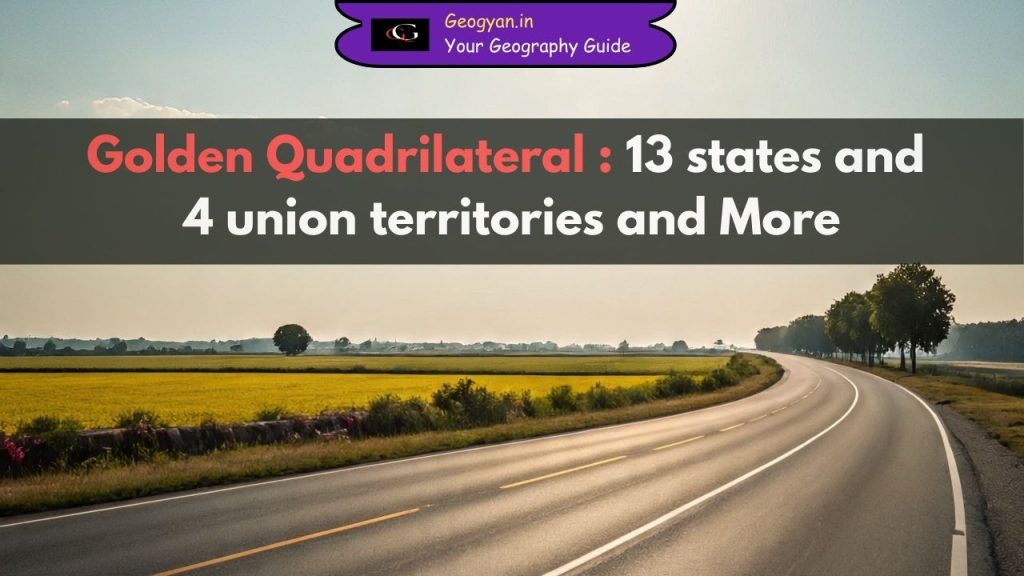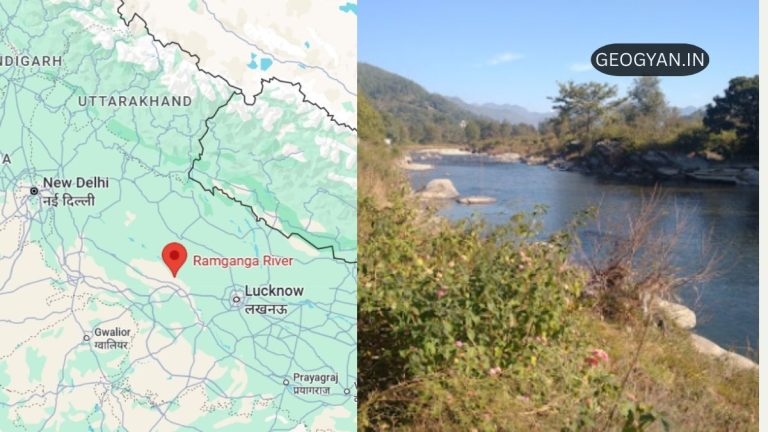Estimated reading time: 4 minutes

Table of contents
Why is Golden Quadrilateral in the News?
In July 2025, the Government of India announced new expansion and modernization plans for the Golden Quadrilateral (GQ) highways, including AI-enabled traffic monitoring systems and smart toll plazas. This ambitious step has once again brought India’s largest highway project into the spotlight. Additionally, the GQ has been integrated with the Bharatmala Phase-II program, ensuring better connectivity with ports and border areas.
What is the Golden Quadrilateral?
The Golden Quadrilateral (GQ) is India’s largest highway project, connecting Delhi, Mumbai, Chennai, and Kolkata in a quadrilateral shape. It is a six-lane superhighway network built to boost economic growth, trade, and national connectivity. This project was a major part of the National Highways Development Project (NHDP), aimed at bringing Indian infrastructure at par with global standards.
- Launched: 2001 under National Highways Development Project (NHDP)
- Completed: 2012 (major sections)
- Total Length: About 5,846 km
- Managed by: National Highways Authority of India (NHAI)
- Purpose: To improve industrial corridors, trade, tourism, and defense movement
It is called a “Quadrilateral” because it connects four major metropolitan cities forming a diamond/rectangular shape on the Indian map. It is the fifth-longest highway network in the world.
Which Cities and Highways are Connected in GQ?
- Delhi to Kolkata (via Kanpur, Varanasi) – NH-19
- Kolkata to Chennai (via Bhubaneswar, Visakhapatnam) – NH-16
- Chennai to Mumbai (via Bengaluru, Pune) – NH-48
- Mumbai to Delhi (via Ahmedabad, Jaipur) – NH-48
This project not only links metros but also connects major industrial, agricultural, and port cities. In total, it passes through nearly 13,000 villages and towns, directly benefiting rural connectivity.
Geographical Importance of Golden Quadrilateral
- Trade & Economy: Nearly 40% of India’s trade movement happens through the GQ. It connects industrial hubs such as Ahmedabad, Surat, Bengaluru, and Bhubaneswar.
- Agriculture: Helps farmers transport crops quickly to markets. It has particularly boosted the supply chains of perishable goods like milk, fruits, and vegetables.
- Urbanization: Boosts growth in tier-2 and tier-3 cities along the route, such as Nagpur, Jaipur, and Guntur.
- Tourism: Improves access to Jaipur, Varanasi, Puri, Mahabalipuram, etc., making it a backbone of cultural tourism.
- Strategic Role: Ensures fast military movement between borders and coasts. It is also vital for disaster management during floods and cyclones.
For exams: Remember that Golden Quadrilateral passes through 13 states and 4 union territories, covering almost 26% of India’s land area.
How is Golden Quadrilateral Different from Bharatmala and North-South-East-West Corridors?
- Golden Quadrilateral (GQ): Connects four metros (Delhi, Mumbai, Chennai, Kolkata).
- North-South-East-West Corridors: Connects Srinagar–Kanyakumari and Silchar–Porbandar. It is longer than GQ but was constructed later.
- Bharatmala Project: A broader plan including border roads, economic corridors, and coastal roads, launched in 2017.
The GQ is considered the foundation stone on which newer projects like Bharatmala and Sagarmala are being built.
Quick Facts Table
| Feature | Details |
| Project | Golden Quadrilateral (GQ) |
| Length | 5,846 km |
| Cities Connected | Delhi, Mumbai, Chennai, Kolkata |
| States Covered | 13 states + 4 UTs |
| Launched | 2001 |
| Completed | 2012 |
| Managed By | NHAI |
| Importance | Trade, defense, tourism, urbanization |
For better recall in exams: GQ is about 1.5 times the length of the Indian Railways’ Golden Chariot route.
The Golden Quadrilateral is not just a highway project; it is a lifeline of India’s economy and infrastructure. By connecting major cities and industrial hubs, it has transformed regional development, trade efficiency, and urban growth. It has reduced travel time between metros by 30–40% and lowered transportation costs significantly.
FAQs
Q1. What is the total length of the Golden Quadrilateral?
About 5,846 km, making it one of the largest highway networks in Asia.
Q2. Which cities are connected by the Golden Quadrilateral?
Delhi, Mumbai, Chennai, and Kolkata, along with major cities such as Jaipur, Bengaluru, and Kanpur on the route.
Q3. When was the Golden Quadrilateral project launched?
It was launched in 2001 by then Prime Minister Atal Bihari Vajpayee as part of NHDP Phase-I.
Q4. Which authority manages the Golden Quadrilateral?
The National Highways Authority of India (NHAI), under the Ministry of Road Transport and Highways.
Q5. How many states are covered under GQ?
It passes through 13 states and 4 union territories, covering nearly 60% of India’s GDP zones.





























